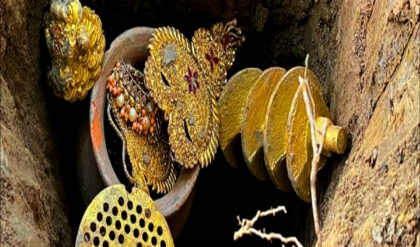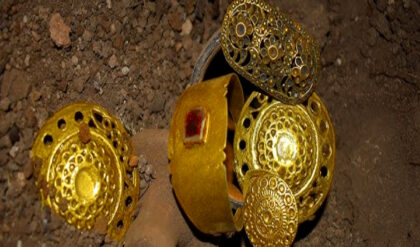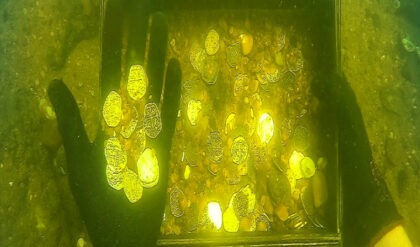- A multinational team of researchers has identified a new family of snakes, Micrelapidae, that lives in East Africa and the Middle East.
- These small, rear-fanged, venomous snakes are thought to have diverged from the rest of the evolutionary tree 50 million years ago and have since evolved separately as a distinct family.
- Kenyan researchers hope the news will help efforts to raise awareness about snakes and their importance to the ecosystem, as it is common for people in Kenya to fear and kill snakes.
In a rare turn of events, scientists have classified a new family of snakes.
Only three known species belong to the recently identified family Micrelapidae . Scientists say these reptiles are believed to have slipped off the snake evolutionary tree 50 million years ago. They were previously considered part of the larger snake family, Colubridae , but DNA testing in recent years has shown otherwise.
Snakes have thin, cylindrical bodies with smooth scales in regular rows and a short, pointed tail. They also have small heads that blend into the neck and often black and yellow rings. The size of these snakes also varies depending on the species, but most are relatively small, measuring between 15 and 60 cm (6 and 23 in) long.
“Today we tend to assume that most large groups of animals, such as families, are already known to science, but sometimes we still encounter surprises, and this is what happened with micrelapid snakes,” said the professor. Shai Meiri of the School of Zoology at Tel Aviv University. he says in a press release.
Researchers at Tel Aviv University hailed these findings as a rare breakthrough in modern science. They were part of a multinational team from Finland, the United States, Belgium, Madagascar, Hong Kong and Israel, including Meiri, who identified the family Micrelapidae . Their findings were published in the journal Molecular Phylogenetics and Evolution in March.
“As far as we know, the new family includes only three species, one in Israel and neighboring countries, and two in East Africa,” the Tel Aviv University scientists say in the press release.

Patrick Malonza, a herpetologist and research scientist at the National Museums of Kenya, confirmed the recent identification of the new family of snakes, some of which live in Kenya.
“Yes, molecular data has shown that they are unique and we are grateful that it has been confirmed that they belong to their own family,” he said.
The snakes belong to the genus Micrelaps , previously classified in the family Colubridae , which includes the vast majority of snakes. “We are aware of the uncertainty and debate around snakes of this genus, now family Micrelapidae ,” Malonza added.
M.piereri are venomous snakes with rear fangs. They are found in sandy desert habitats in southern Israel and also in parts of the Occupied Palestinian Territories, Jordan and Syria. The arid lands of Kenya and Tanzania are also home to two species of these small, mostly harmless snakes from the same newly identified genus and family: M. vaillanti , the desert black-headed snake, is common in the northeast, east, south and southeastern Kenya. M. bicoloratus , known as the Kenyan two-headed snake, is found in Maasai land, Somaliland, the Laikipia Plateau, Ukambani, Tsavo, Thika, Lamu and Garissa.
“These are pretty friendly snakes that are mostly harmless to humans, and should not be chased [killed],” Malonza said. “They are really beautiful to look at in terms of aesthetic value.”
Many people in Kenya kill snakes on sight, especially poisonous ones. While snakes play an important role in the ecosystem, experts urge caution and education.
In many African cultures, snakes are associated with evil or witchcraft, resulting in their indiscriminate killing; However, Kenya Wildlife Service (KWS) Nyanza Region Senior Director Christine Boit says some species of snakes play an important role in controlling rodent populations, pest control, maintenance of the food chain and maintenance of ecosystem balance.
In addition to their ecological importance, snakes are also important cultural symbols in some African communities who view snakes as protectors or symbols of good luck, and killing them can be disrespectful or taboo.
“The indiscriminate killing of snakes is not good for the environment,” says Boit. “We need to educate people on how to safely identify and handle snakes, especially non-venomous snakes.”

Boit also warns against killing snakes without the proper equipment and knowledge, as this can be dangerous. “We advise people to call professionals or wildlife experts to handle snakes, especially venomous ones,” she says.
Snakes have ecological and cultural significance, and she says she wants communities to dispel myths and fears surrounding snakes and promote peaceful coexistence.
Despite their wide distribution, species belonging to the Micrelapidae family are not currently in danger of extinction. Still, Malonza emphasizes the importance of raising awareness among the local community about the relevance of snakes in the ecosystem. “These snakes are natural predators of rodents, which can damage crops and spread diseases. By feeding on rodents, Micrelapidae snakes help keep their populations under control,” he says.
Malonza also points out that Micrelapidae snakes provide food for other animals. “Birds of prey and other snakes feed on Micrelapidae snakes, which support the broader food web of their ecosystem,” he says.
Micrelapidae snakes also promote biodiversity. “As with other species, Micrelapidae snakes contribute to the overall biodiversity of the ecosystem. By filling their unique ecological niche, they support the diversity of life in their habitat,” according to Malonza.
During the research process, the international team examined the structure of the snake using micro-CT (high-resolution magnetic imaging) technology, focusing mainly on the skull.
They also used deep genomic sequencing tools to look at 4,500 “ultraconserved elements,” parts of the genome that require millions of years to show changes. “In addition to Micrelaps DNA, we took DNA samples from several groups of snakes to which they could have belonged. In this way, we discovered in Micrelaps some unique genomic elements, which were not found in any of the other groups,” according to Meiri.
Malonza says these technologies could also be extended to identify other animal species.
The identification of a new family of snakes should be a source of pride for Kenyans, he says. “It implies that we should be proud as a community that these species are also present in Kenya, and we should strive to conserve the species and their habitats for future generations to marvel at.”
According to researchers, Micrelaps snakes split off from the rest of the snake evolutionary tree about 50 million years ago and have evolved independently as a different, separate family ever since. Researchers suspect that the snakes originated in Africa and, at some point, some of them probably migrated north through the Great Rift Valley. “Since most animals have already been classified into well-defined families, such a discovery of a new family is quite rare in modern science,” according to Meiri.
DiCaprio’s newly described snake and others threatened by mining in Ecuador and Panama
Citation:
Das, S., Greenbaum, E., Meiri, S., Bauer, AM, Burbrink, FT, Raxworthy, CJ, … Merilä, J. (2023). Phylogenomic systematics based on ultraconserved elements of the snake superfamily Elapoidea, with the description of a new Afroasiatic family. Molecular Phylogenetics and Evolution , 180 , 107700. doi:10.1016/j.ympev.2022.107700
 Article published by
Article published by




